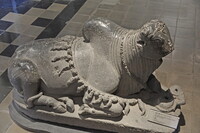| dc.coverage.spatial | Site: Prince of Wales Museum of Western India (Mumbai, Mahārāshtra, India) S 574 | en_US |
| dc.coverage.temporal | late 6th century CE (creation) | en_US |
| dc.creator | unknown (Indian (South Asian)) | en_US |
| dc.date | 550-600 | en_US |
| dc.date.accessioned | 2016-08-23T18:14:05Z | |
| dc.date.available | 2016-08-23T18:14:05Z | |
| dc.date.issued | 550-600 | en_US |
| dc.identifier | 268044 | en_US |
| dc.identifier.other | archrefid: 3403 | en_US |
| dc.identifier.uri | http://hdl.handle.net/1721.3/184358 | |
| dc.description | Overall side view from above (head damaged); Numerous temples in ruins, ancient brickwork and scattered idols found at the Shamlaji site show that since ancient times it was an important center of pilgrimage on the highway between Gujarat and Rajasthan. This sculpture is from the Ranacchodji (or Ranchhodji) temple, Shamalaji, Gujarat (across the Meshwo (Mesvo) river from the Shamalaji temple). Nandi is the name for the bull which serves as the mount (Sanskrit: Vahana) of the god Shiva and as the gatekeeper of Shiva and Parvati. Temples venerating Shiva display stone images of a seated Nandi, generally facing the main shrine and / or flanking the entrance. Source: Wikipedia; http://en.wikipedia.org/wiki/Main_Page (accessed 4/15/2015) | en_US |
| dc.format.medium | schist stone | en_US |
| dc.rights | © Scott Gilchrist, Archivision, Inc. | en_US |
| dc.subject | animal | en_US |
| dc.subject | Hinduism | en_US |
| dc.subject | Saivism | en_US |
| dc.subject | Shaivism | en_US |
| dc.title | Nandi | en_US |
| dc.title.alternative | Nandi (Bull, the mount of Shiva) | en_US |
| dc.type | image | en_US |
| dc.rights.access | Licensed for educational and research use by the MIT community only | en_US |
| dc.identifier.vendorcode | 7A2-IN-PWM-NAN-A01 | en_US |
| vra.culturalContext | Indian (South Asian) | en_US |
| vra.technique | carving (processes) | en_US |
| vra.worktype | sculpture (visual work) | en_US |
| dc.contributor.display | unknown (Indian) | en_US |

